|
Adolf Hitler Visits His
Homeland
Hitler visited Austria immediately following
the Anschluß, or union of Germany with Austria, on 12 March 1938. Although the Anschluß
has gone down in history (through hindsight) as being largely unpopular with the Austrian
people, this is somewhat of a misconception. It is true that the Austrian government of
1938 opposed the union, but the people of Austria had been in favor of union with Germany
since 1919, when the Austria-Hungarian Empire was dissolved by the victorious Allies
following World War I. Even the Austrian government supported a customs union, and
eventual complete Anschluß, between the two countries in 1931. This government
support cooled after Adolf Hitler became chancellor of Germany in 1933, but the popular
support for Anschluß never waned. Certainly, Hitler and the Germans were greeted
by huge crowds in places such as Braunau, Linz, Salzburg, and Vienna, all apparently happy
to celebrate the Anschluß.
Adolf Hitler's Birthplace
-- Braunau, Austria
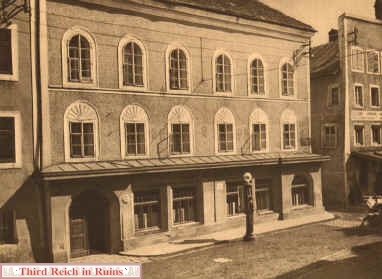
|

|
Adolf Hitler was born in this
house in Braunau am Inn, Austria, on 20 April 1889. In 1889 the building was the Gasthof
Dafner, and the address was Vorstadt 219 (at some point, when this photo was taken, it
was apparently a gas station). (from Heinrich Hoffmann, Hitler, wie ihn keiner kennt
(Hitler, As No-one Knows Him), Berlin, 1932) (MapQuest
Map Link) The house
itself is unmarked today, but a rock memorial stands on the sidewalk in front. For the curious,
the address now is Salzburger Vorstadt 15. According to a 1939-dated
postcard in the author's collection, Hitler was born in the room third from the left on the upper
floor (with the open window in the modern photo). The
U.S. Army CIC (Counterintelligence Corps) had a field office in Hitler's
birth house from 1945-1952 (thanks to Martin Nelson for this info).
In late 2016 the Austrian government seized the house
from its owner, and the future of the house is unclear. It may be
demolished, or the front face may be so changed as to make it
unrecognizable from
the appearance shown here. |
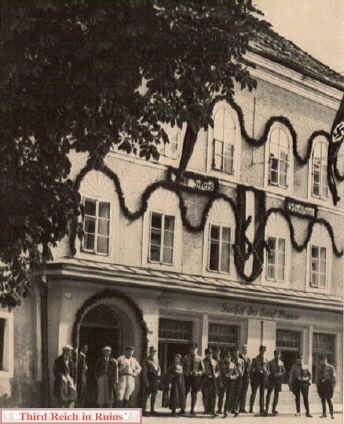
|

|
This view shows the house as it
appeared during much of the Third Reich period, decorated with garlands and
swastikas. (from "Adolf Hitler,"
Cigaretten-Bilderdienst, 1936) |
This colorized period photo shows
an SA parade past the house, which is labeled "Adolf Hitlers Geburtshaus."
(TimePics collection) |

(from Ich kämpfe, Munich, 1943)
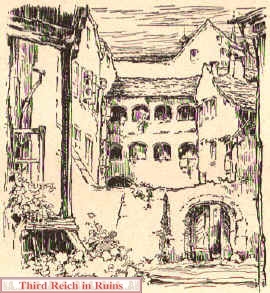
|
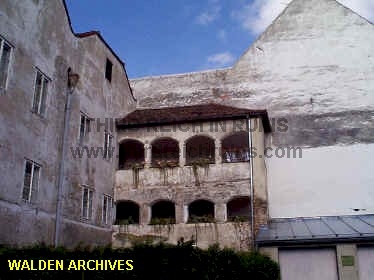
|
Hitler's birthplace inspired
several Third Reich artists, whose works were often displayed at the Haus der Deutschen Kunst in Munich. "Das Geburtshaus des
Führers in Braunau am Inn - Hofseite" by Paul Geißler, 1943 (from Kunst der
Volk, Vienna, Hoffmann, 1943). |
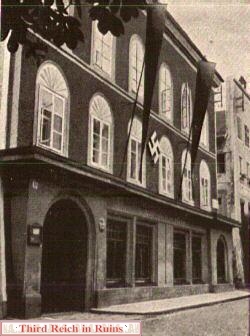
|

|
| These photos show the
front and back of the house as it appeared during the period following the Anschluß,
1938-1945. (from "Wie die Ostmark ihre Befreiung erlebte - Adolf Hitler und sein
Weg zu Großdeutschland," Heinrich Hoffmann, 1938) |

View looking down Adolf Hitler Straße toward the
main square in Braunau.
Hitler's birth house is on the right. (period postcard in author's collection)
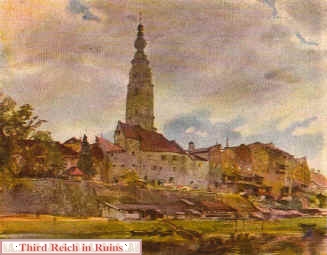
|
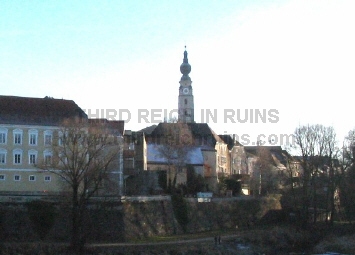
|
Another period painting --
"Braunau am Inn" by F. X. Weidinger, 1943 (from Kunst der Volk, Vienna,
Hoffmann, 1943), with a similar view today, taken from the
Inn River bridge. |

|
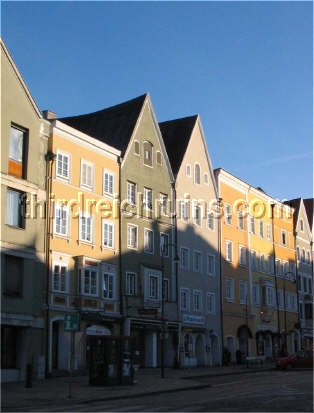
|
On 12 March 1938, following the
Austrian Anschluß, Hitler returned to Braunau, to a thunderous welcome from the
people of his hometown. His car is seen here just at the Braunau end of the Inn River
bridge. The original iron
bridge between Simbach (Germany) and Braunau (Austria) has been replaced by a modern
concrete span, but the Braunau buildings in the background retain their original appearance.
In the period view below, looking the other direction (back toward
Germany), a swastika
flag can be seen draped over the
Austrian Doppeladler (Double Eagle) at the bridgehead. (from
Heinrich Hoffmann, "Hitler in seiner Heimat," (Munich, 1938) |
 |
 |

|

|
Although
Hitler was photographed riding down the main street of Braunau, in the
direction of his birth house, no photos show him actually visiting the
place of his birth. (Hoffmann, "Hitler in seiner Heimat") |
From Braunau, Hitler
travelled to Linz, passing sites from his youth, such as the school he had attended in Fischlham near Lambach,
and the house where his family lived in Leonding, near Linz (Hitler would later
return to visit some of these sites as well).

|
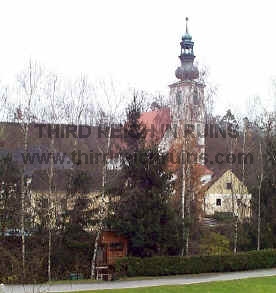
|
| Adolf Hitler attended
his first two years of school in Fischlham, near Lambach, a town
southwest of Linz. The period scene (on the left) is a sketch by artist Paul Geißler,
part of a special showing of artwork on Hitler's youth at the Haus
der Deutschen Kunst 1943 exhibition (from Heinrich Hoffmann, Kunst dem Volk,
Vienna, 1943 (author's collection). The school was the low building at left, with three
windows. |

|

|
Front of the Fischlham school,
from a period postcard. |
The school building today (it is
no longer a school). |

|

|
Fischlham school
building in the 1930s (seen from the other side)
(from "Wie die Ostmark ihre Befreiung erlebte - Adolf Hitler und sein Weg zu
Großdeutschland,"
Heinrich Hoffmann, 1938 (author's collection) |
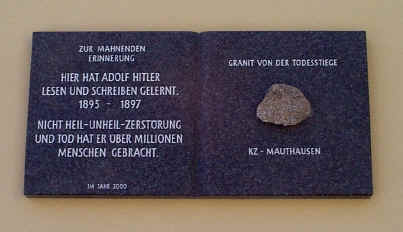
This marker was placed on the former school
building in 2000. It reads, "In Memoriam;
Adolf Hitler learned to read and write here, 1895-1897; Not Heil - Unheil - He brought
destruction and death to millions of people." On the other side is a piece of granite
from the Stairway of Death at Mauthausen concentration camp.
Click
here for a MapQuest map link to Fischlham.
-

|
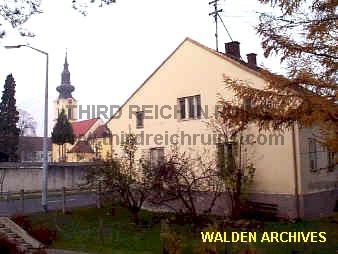
|
| After Hitler's father
retired from the Austrian customs service, he moved his family to Leonding,
a suburb of Linz. Adolf Hitler always looked back on his early years in Leonding as the
happiest of his life, and he always thought of Linz as his home town. The painting on the
left was by F. X. Weidinger, another of the special 1943 exhibition (Hoffmann, Kunst
dem Volk, 1943). The Hitler house is in the left center of the view, in front of the
church. Other houses hide a duplicate view today, but this modern view shows the church
from the side yard of the former Hitler house. |
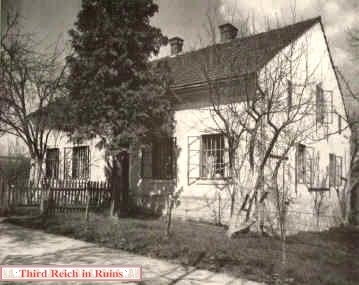
|

|
| The former Hitler house
is located today at Michaelsbergstraße 16 in Leonding. The building was in
disrepair for several years, but in 2002 it was refurbished and now serves
as an office for the cemetery across the street. The period view is from Rudolf
Lenk, Oberdonau, die Heimat des Führers ("Upper Danube, the Homeland of the
Führer"), Munich, Bruckmann Verlag, 1940.
|

|

|

|
| Hitler visits his
parents' house in Leonding, 13 March 1938. (period photos from Heinrich Hoffmann, Hitler
in seiner Heimat, Munich, 1938) |
 |
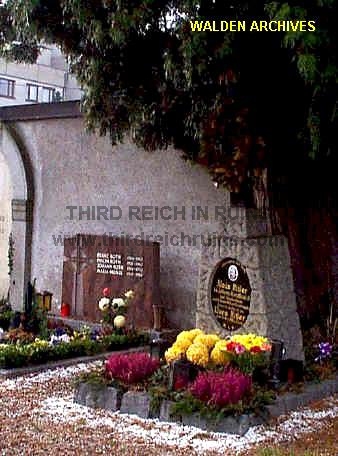 |
 |
| While in
Leonding,
Hitler visited the cemetery across the street from his former house, to decorate
the grave of his parents Alois and Klara. The grave was still well maintained and decorated until
2012, but in March 2012 the grave marker was removed at the insistence of
Austrian politicians. (Hoffmann, Hitler in seiner Heimat;
period postcard) |
 |
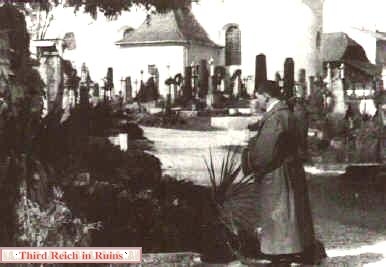
|

|
| These photos show the
grave location in relation to the church -- the grave is under a large fir tree against
the dividing wall at the left of the photos. ("Unser Führer," special
edition of the "Illustrierter Beobachter" for Hitler's 50th birthday, 20 April
1939, Munich, Franz Eher Verlag) |

|

|
| Hitler's
father Alois died in 1903 during a morning visit to his favorite pub, the
Gasthof Wiesinger, down the street from his house on Michaelsbergstraße.
He collapsed and died while seated at the couch shown below, which still
exists in the Gasthof. (postcard dated 1950) |
 |
Click
here for a Google Maps link to Leonding.
-

|

|
| On the
evening of 12 March 1938, in an emotional speech
from the balcony of the Linz town hall, Hitler declared Germany and Austria
(Ostmark) united as one entity, the beginning of
the Großdeutsches Reich (Greater German Empire). (Henrich
Hansen, "Volk will zu Volk," 1938) |
 |
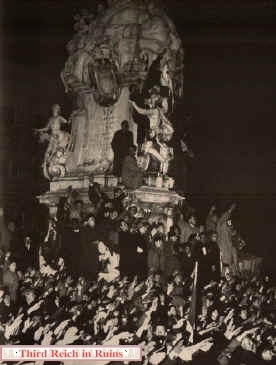
|

|
| Jubilant crowds in the
Linz Hauptplatz, some climbing on the Dreifaltigkeitssäule, greet Hitler's speech.
(from Hoffmann, Hitler
in seiner Heimat) |
 |
 |
| Sometime
during the period following the Anschluß, perhaps for a visit by
Hitler, the Burschenschafterturm, part of the 19th century
fortifications of the city of Linz, was decorated with a swastika banner
and the Nazi slogan "Ein Volk, Ein Reich, Ein Führer" (One
People, One Country, One Leader). The tower stands today as a monument
to war dead and a museum of the students association. (courtesy
Ralf Hornberger) |

|

|
| On his way to
Vienna on 14 March 1938, Hitler passed by the famous Benedictine
Abbey at Melk, overlooking the Danube. In the modern photo, trees block the view of the
river to the left. (Heinrich Hoffmann, "Wie die Ostmark ihre Befreiung
erlebte - Adolf Hitler und sein Weg zu Großdeutschland," 1938 (author's collection) |

|
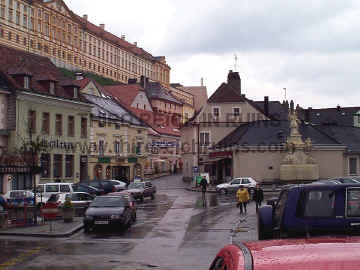
|
| The Führer's motorcade
passed directly through the center of Melk, beneath the Abbey on the hill to the left. The
view remains practically unchanged today. (Heinrich Hoffmann, "Hitler in
seiner Heimat," Munich, 1938 (author's collection) MapQuest
Map Link |

|
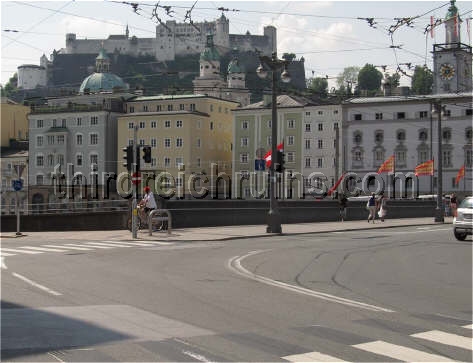
|
Forces
of the German Wehrmacht entered Salzburg, Austria, on the morning of 12
March 1938. The soldiers crossed the Staatsbrücke bridge into the
Old City of Salzburg, with the Festung Hohensalzburg fortress seen
on the hill in the background. (above - Heinrich Hoffmann,
"Hitler baut Grossdeutschland," (
Munich, 1938); below - "Illustrierter Beobachter," 20 March 1938) |
 |
 |

|

|
Above -
Maximum use was made of these images for propaganda purposes. A photo
taken at nearly the same moment as that on the left above was used to
produce the poster on the right.
Below - A view from a different angle on the Staatsbrücke showing
the same mountain howitzer battery with mule transport. (above -
Bundesarchiv; below- Hoffmann, "Hitler baut Grossdeutschland") |
 |
 |

|

|
Hitler
visited Salzburg on 6 April 1938, crossing the Staatsbrücke as had
his troops the previous month. A rally was held in the Residenzplatz,
with the famous Residenzbrunnen fountain seen in the
foreground. (Hoffmann, "Hitler baut Grossdeutschland") |
 |
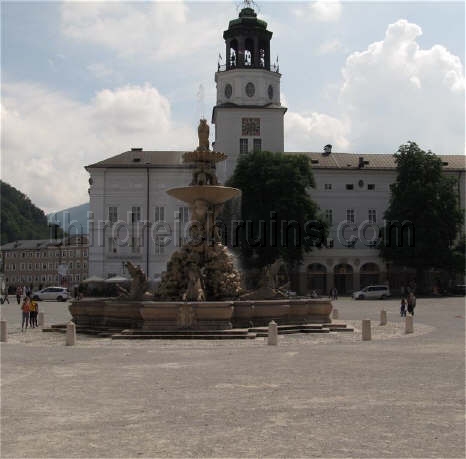 |
 Continue to Vienna Continue to Vienna
|
